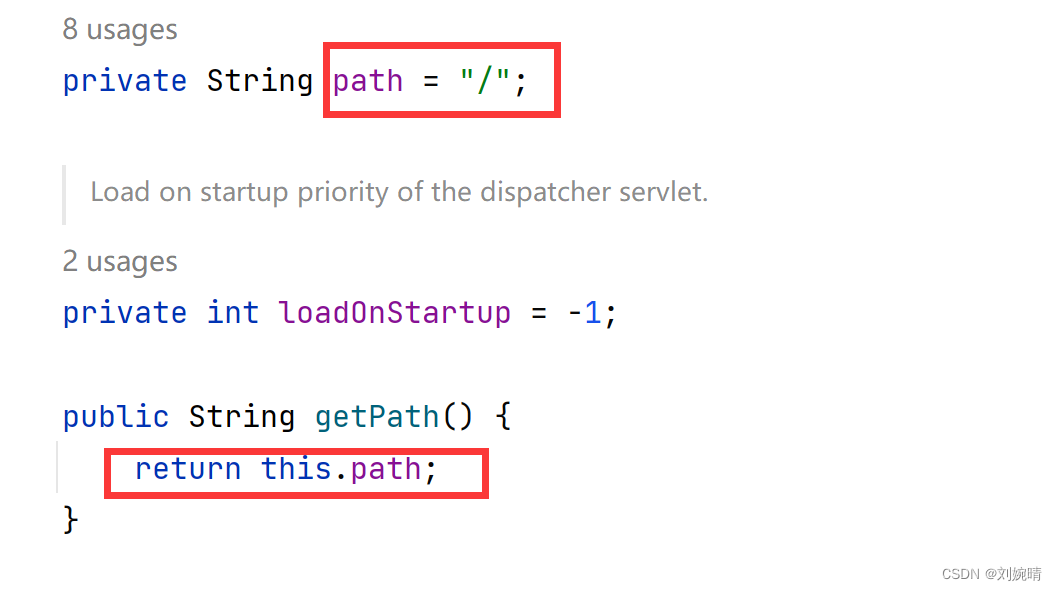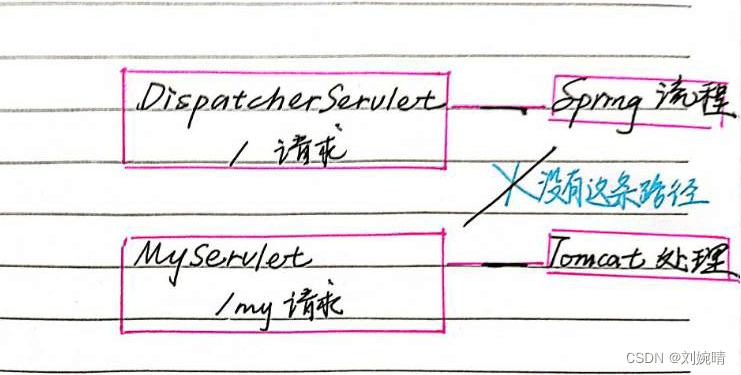SpringBoot原生组件注入实现两种方式介绍
原生组件注入SpringBoot,即注册 Servlet 、Filter、Listener 进入 SpringBoot
一、使用 Servlet API
使用 Servlet API 可以实现原生组件注入,通过在自定义 Servlet 前加入 @WebServlet 注释,并且在 SpringBoot 启动类前加入 @ServletComponentScan 注释,可实现注册 Servlet
代码示例:
1、实现自定义 MyServlet
自定义 Servlet 类:
@WebServlet(urlPatterns = "/my") // 加入 @WebServlet 注释
public class MyServlet extends HttpServlet { // 注意要继承 HttpServlet 类
@Override // 重写 DoGet 方法
protected void doGet(HttpServletRequest req, HttpServletResponse resp) throws ServletException, IOException {
resp.getWriter().println("haha");
}
}项目启动类:
@ServletComponentScan(basePackages = "com.wanqing.admin") //扫描那个包中有servlet
@SpringBootApplication
public class DemoAdminApplication {
public static void main(String[] args) {
SpringApplication.run(DemoAdminApplication.class, args);
}
}2、实现自定义 MyFilter
@Slf4j
@WebFilter(urlPatterns = {"/css/*", "/images/*"}) // 拦截静态资源
public class MyFilter implements Filter {
@Override
public void init(FilterConfig filterConfig) throws ServletException {
Filter.super.init(filterConfig);
log.info("MyFilter初始化完成");
}
@Override
public void doFilter(ServletRequest servletRequest, ServletResponse servletResponse, FilterChain filterChain) throws IOException, ServletException {
log.info("MyFilter工作");
filterChain.doFilter(servletRequest, servletResponse);
}
@Override
public void destroy() {
Filter.super.destroy();
log.info("MyFilter销毁");
}
}3、实现自定义 MyServletContextListener
@WebListener
@Slf4j
public class MyServletContextListener implements ServletContextListener {
@Override
public void contextInitialized(ServletContextEvent sce) {
log.info("MyServletContextListener 监听到项目初始化完成");
}
@Override
public void contextDestroyed(ServletContextEvent sce) {
log.info("MyServletContextListener 监听到项目销毁");
}
}二、使用 RegistrationBean 的方式注入原生组件
通过编写 MyRegistConfig 配置类,返回 RegistrationBean 的方式实现组件的注入,与上一种方式的区别在于,这种方式不需要给 自定义 Servlet 类写 @WebServlet 注释。
注意点:要记得使用 @Bean 注释将 ServletRegistrationBean 注册到容器中。
代码示例:
自定义 MyRegistConfig 配置类,注册 myServlet 组件,返回 ServletRegistrationBean 对象 (对象参数为自定义的 myServlet 对象实例)
myFilter 及myListener 的实现方式同理
@Configuration
public class MyRegistConfig {
@Bean
public ServletRegistrationBean myServlet(){
MyServlet myServlet = new MyServlet();
return new ServletRegistrationBean(myServlet, "/my","/my02");
}
@Bean
public FilterRegistrationBean myFilter(){
MyFilter filter = new MyFilter();
//return new FilterRegistrationBean(filter, myServlet()); // 拦截myServlet()的路径
FilterRegistrationBean filterRegistrationBean = new FilterRegistrationBean(filter);
filterRegistrationBean.addUrlPatterns("/my","/css/*");
return filterRegistrationBean;
}
@Bean
public ServletListenerRegistrationBean myListener(){
MyServletContextListener myServletContextListener = new MyServletContextListener();
return new ServletListenerRegistrationBean(myServletContextListener);
}
}拓展:为什么拦截器不拦截 我们自定义的 MyServlet 请求?
分析 DispatcherServlet 如何注册进入容器中,从 DispatcherServletAutoConfiguration 类开始
容器中自动配置了 DispatcherServlet 组件,其属性绑定到 WebMvcProperties 中,对应的配置文件是 spring.mvc
@Bean(name = DEFAULT_DISPATCHER_SERVLET_BEAN_NAME) // 注册 DispatcherServlet 组件
public DispatcherServlet dispatcherServlet(WebMvcProperties webMvcProperties) {
DispatcherServlet dispatcherServlet = new DispatcherServlet();
dispatcherServlet.setDispatchOptionsRequest(webMvcProperties.isDispatchOptionsRequest());
dispatcherServlet.setDispatchTraceRequest(webMvcProperties.isDispatchTraceRequest());
dispatcherServlet.setThrowExceptionIfNoHandlerFound(webMvcProperties.isThrowExceptionIfNoHandlerFound());
dispatcherServlet.setPublishEvents(webMvcProperties.isPublishRequestHandledEvents());
dispatcherServlet.setEnableLoggingRequestDetails(webMvcProperties.isLogRequestDetails());
return dispatcherServlet;
}通过 ServletRegistrationBean < DispatcherServlet > 机制(DispatcherServletRegistrationBean.class)将 DispatcherServlet 原生的 Servlet 组件配置进来
@Bean(name = DEFAULT_DISPATCHER_SERVLET_REGISTRATION_BEAN_NAME)
@ConditionalOnBean(value = DispatcherServlet.class, name = DEFAULT_DISPATCHER_SERVLET_BEAN_NAME)
public DispatcherServletRegistrationBean dispatcherServletRegistration(DispatcherServlet dispatcherServlet,
WebMvcProperties webMvcProperties, ObjectProvidermultipartConfig) {
DispatcherServletRegistrationBean registration = new DispatcherServletRegistrationBean(dispatcherServlet,
webMvcProperties.getServlet().getPath()); // 拿到默认映射路径为 / 路径
registration.setName(DEFAULT_DISPATCHER_SERVLET_BEAN_NAME);
registration.setLoadOnStartup(webMvcProperties.getServlet().getLoadOnStartup());
multipartConfig.ifAvailable(registration::setMultipartConfig);
return registration;
}拿到默认映射路径 /
WebMvcProperties.class 中配置

使用 Tomcat 做原生 Servlet 开发,如果多个 Servlet 都能处理到同一层路径,是精确优先原则,例如:
A:/my/
B: /my/1
发送 /my/1 请求 B处理,而发送 /my/2 请求 A 处理
结论 : 来到 /my 不经过 / —— 精确匹配 /my 直接经 Tomcat 写出响应,不经过 SpringMVC 的一系列流程,因此不被拦截器拦截,如下图所示:
